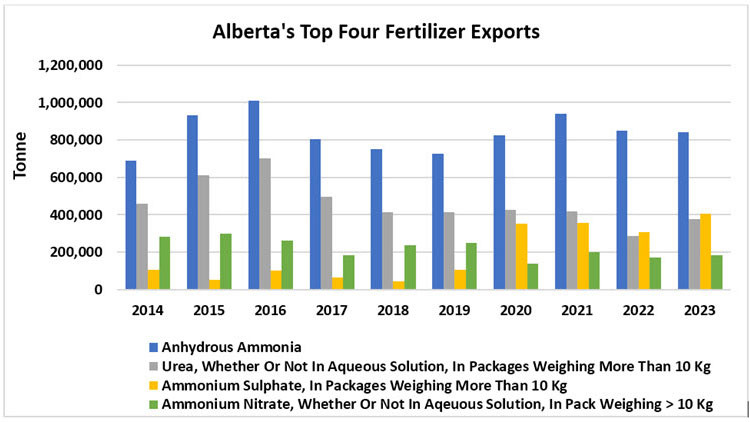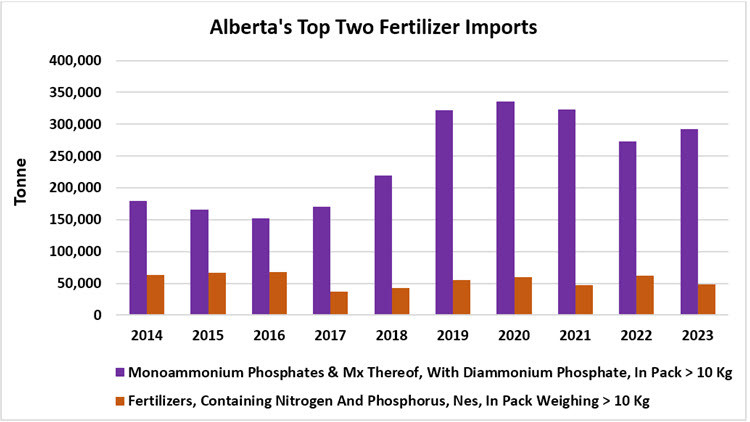Non-urgent government operations are closed December 24 to January 1, reopening January 2. View available services during this period.
See event listings and more articles in this edition of Agri-News: February 26, 2024 issue
“Fertilizers are essential inputs for agricultural production,” says Azam Nikzad, market analyst/coordinating researcher with the Alberta government. “In Alberta, fertilizer and lime accounted for approximately $2.5 billion of total farm operating expenses in 2022. Domestic demand for fertilizer is tied to seeded area and farm income, which is influenced by global crop prices.”
The fertilizer industry is global. The total market was valued at US$202 billion in 2023, with nitrogenous fertilizers being the most traded type, followed by phosphate and potash. Since Alberta is part of and contributes to the global fertilizer market, it becomes imperative to delve into the import and export dynamics that shape the province's role in this vital sector.
Alberta is a large producer of nitrogen. This is due to the availability of natural gas in the region, which is a key input used in the Haber-Bosch process (a method for manufacturing anhydrous ammonia). Alberta is also the largest sulfur producer in Canada. Sulfur is a by-product of natural gas and oil refining.
“Alberta exports nitrogen and sulfur-based fertilizers, including anhydrous ammonia, urea, ammonium sulphate and ammonium nitrate,” says Nikzad. “The combined volume of these 4 fertilizers reached above 1.8 million tonnes in 2023 and accounted for 98.8% of total fertilizer export volume from the province. In the last decade, ammonium sulphate exports demonstrated a consistent increase, while the remaining fertilizer exhibited fluctuations with ups and downs in their export volumes.
Figure 1. Alberta’s top 4 fertilizer exports

Alberta exported 22.1% of its total anhydrous ammonia production in 2022. This positioned Canada as the fifth largest exporter of ammonia in the world. Additionally, urea exports were 11.1% of Alberta's total urea production in the same year. The United States is the major export destination for Alberta’s fertilizers.
“Alberta does not make all the different types and formulations of fertilizer products needed by farmers,” explains Nikzad. “The province gets potash from Saskatchewan and relies on imported phosphate, primarily from the United States and Morocco. Alberta imports Monoammonium Phosphate (MAP) + Diammonium Phosphate (DAP), as well as compound fertilizers that contain nitrogen and phosphorus.”
The import volume of these fertilizers amounted to 340,833 tonnes, which represented 82.5% of the total import volume in 2023. MAP + DAP alone accounted for 70.7% of overall import volume during the same period.
Figure 2. Alberta’s top 2 fertilizer imports

“The fertilizer market is tied to global supply and demand dynamics, while political and geopolitical factors have added to the complexity of the situation in recent years. At the same time, strong crop prices boosted fertilizer demand that created a gap between global demand and supply. Global supplies currently continue to face a number of challenges, with Europe reducing nitrogen fertilizer production due to high natural gas prices and China restricting exports to secure supply and lower domestic prices.”
A similar scenario is unfolding for phosphate where a global shortage is exacerbated by geopolitical tensions, particularly the Russia-Ukraine war and conflict in the Middle East. China is a major contributor to global phosphate fertilizer supply and has implemented export restrictions on this product as well.
Closer to home, the shutdown of a phosphate facility in Redwater is another factor that has potential to impact the domestic supply situation. The plant strategically shifted focus from phosphate production to ammonium sulphate. The transition has consequences for phosphate production and will necessitate increased imports of phosphate fertilizer from the United States or from overseas.
“Western Canada has the capacity to produce most of the fertilizers demanded by farms, with the exception of phosphorus-based products, where we rely on imports,” explains Nikzad. “This is not to suggest there will never be a supply disruption or localized shortage. Transportation and other logistical factors can impact product availability and affect market prices. As well, demand for specialized fertilizers is increasing and it can sometimes outpace production capacity but will be a topic for a future article.”
Contact
Connect with Azam Nikzad for more information:
Phone: 780-422-0264
Sign up for Agri-News
Start every Monday with the week’s top agricultural stories and latest updates.
Read about all things agriculture at Alberta.ca/agri-news